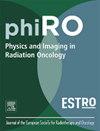肺癌患者放化疗期间4级放射诱导淋巴细胞减少的预测:来自过去两项试验的见解
IF 3.3
Q2 ONCOLOGY
引用次数: 0
摘要
背景和目的放射诱导淋巴细胞减少症(RIL)是放射治疗(RT)的重要副作用,具有重要的预后意义。我们开发并测试了局部晚期非小细胞肺癌(NSCLC)患者同时接受化疗和放疗的4级(G4) RIL的正常组织并发症概率(NTCP)模型,分析了两项临床试验的患者数据。材料与方法回顾性分析NCT00915005 (MDA-cohort)和NCT00533949 (RTOG0617-cohort)试验的数据。在找到G4-RIL的候选预测因子后,定义为最低点的绝对淋巴细胞计数(ALC);0.2*109细胞/l,我们在mda队列上训练了NTCP模型,并基于两个队列中的常见可用变量在rtog队列上进行了测试。从判别和校准两个方面对模型性能进行了评估。结果在mda组中,161例患者中有55例(34%)发展为G4-RIL,而在rtog组中,227例患者中有16例(7%)发展为G4-RIL。在NTCP模型中,选择接受至少5Gy辐射的健康肺的相对体积(V5Gy)和基线ALC作为预测因子,具有良好的判别性能(交叉验证ROC-AUC: 0.68)。V5Gy的预测价值在rtog0917队列中得到了证实(ROC-AUC: 0.67),尽管其验证受到次优校准的限制,可能是由于队列之间的差异。结论基线ALC和肺V5Gy被确定为G4-RIL的预测因子,与先前的研究结果一致。旨在减少肺部低剂量浴的治疗计划优化可能是缓解严重RIL的有效策略。本文章由计算机程序翻译,如有差异,请以英文原文为准。
Prediction of Grade 4 radiation-induced lymphopenia during chemoradiation therapy for lung cancer patients: Insights from two past trials
Background and Purpose
Radiation-induced lymphopenia (RIL) is a significant side effect associated with radiation therapy (RT) with important prognostic implications. We developed and tested a normal tissue complication probability (NTCP) model for Grade 4 (G4) RIL in patients with locally advanced Non-Small-Cell Lung Cancer (NSCLC) who underwent concurrent chemotherapy and RT, analyzing data from patients enrolled in two clinical trials.
Materials and Methods
We retrospectively analyzed the data from NCT00915005 (MDA-cohort) and NCT00533949 (RTOG0617-cohort) trials. After finding the candidate predictors of G4-RIL, defined as absolute lymphocyte count (ALC) at nadir < 0.2*109 cells/l during RT, we trained an NTCP model on the MDA-cohort and tested it on the RTOG-cohort, based on common available variables in the two cohorts. Model performance was assessed in terms of discrimination and calibration.
Results
In the MDA-cohort, 55 out of 161 (34%) patients developed G4-RIL, while in the RTOG-cohort 16 out of 227 (7%) developed this condition. The relative volume of healthy lungs receiving at least 5 Gy (V5Gy) and baseline ALC were selected as predictors in an NTCP model, with good discriminative performances (cross validated ROC-AUC: 0.68). The predictive value of V5Gy was confirmed in the RTOG0917-cohort (ROC-AUC: 0.67), although its validation was limited with suboptimal calibration, potentially due to discrepancies between cohorts.
Conclusions
Baseline ALC and lung V5Gy were identified as predictors for G4-RIL, consistent with findings from previous studies. Treatment plan optimization aiming at reducing low-dose bath in the lungs could be an effective strategy for severe RIL mitigation.
求助全文
通过发布文献求助,成功后即可免费获取论文全文。
去求助
来源期刊

Physics and Imaging in Radiation Oncology
Physics and Astronomy-Radiation
CiteScore
5.30
自引率
18.90%
发文量
93
审稿时长
6 weeks
 求助内容:
求助内容: 应助结果提醒方式:
应助结果提醒方式:


